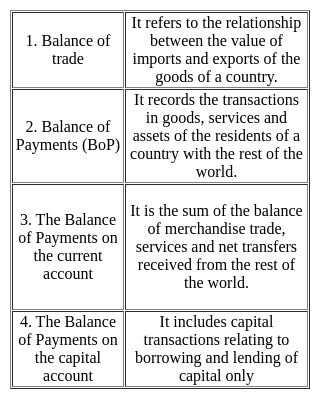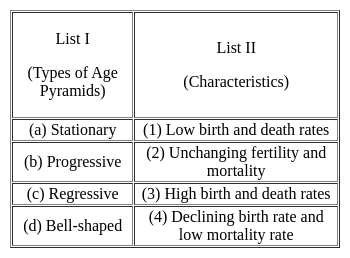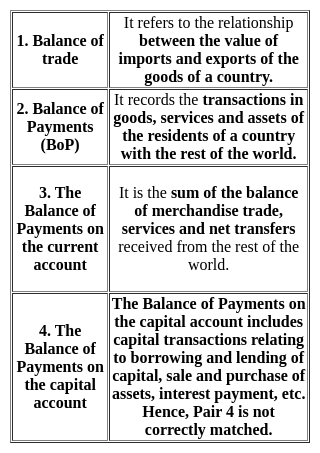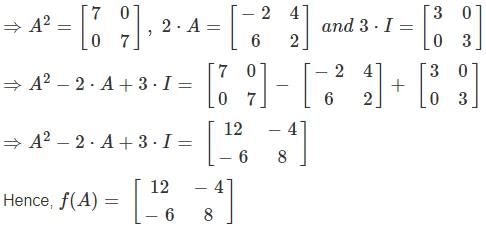UGC NET Paper 2 Economics Mock Test - 8 - UGC NET MCQ
30 Questions MCQ Test UGC NET Mock Test Series 2025 - UGC NET Paper 2 Economics Mock Test - 8
In a test, the probability of A passing the test is 3/17 and the probability of B passing the test is 9/14. Find the probability of both of them failing the test.
Which of the following statements accurately describes the relationship between the Lindahl equilibrium, Wicksell's proposal, marginal social cost, Samuelson's theory of public expenditure, and the free riders' problem?
What is the main difference between a stationary and non-stationary time series?
If the RBI decides to adopt an expansionist monetary policy, which of the following would it not do?
1. Cut and optimize the Statutory Liquidity Ratio
2. Increase the Marginal Standing Facility Rate
3. Cut the Bank Rate and Repo Rate
Select the correct answer using the code given below:
Which of the following pair is not correctly matched?

Select the correct answer using the code given below:
Which of the following does not come under the category of Revenue receipts?
1. Receipts by the government through Provident Fund and other Small-saving schemes
2. Grants which the governments receive.
3. Loan recovery.
4. Profits from PSUs.
5. Fees, Penalties and fines received by the government.
6. External borrowings by the government.
Select the correct answer using the code given below:
Given below are two statements: One is labeled as Assertion A and the other is labeled as Reason R.
Assertion A: Payment banks - which can accept deposits but are prohibited from lending - need to be part of the UPI ecosystem.
Reason R: Loading fees on transactions through UPI, payment banks can widen the adoption of wallets among customers and merchants.
In the light of the above statements, choose the correct answer from the options given below:
Which of the following is a producer good?
The Reserve Bank of India (RBI) has revised regulations for _____ lenders by directing them to get themselves rated by March 2016.
The Cabinet Committee on Economic Affairs (CCEA) on 28th Jan 15 approved a proposal of which bank to raise the foreign holding limit to 74 per cent?
Which of the following is/are the aim/aims of "Digital India" Plan of the Government of India?
1. Formation of India's own Internet companies like China did.
2. Establish a policy framework to encourage overseas multinational corporations that collect Big Data to build their large data centres within our national geographical boundaries.
3. Connect many of our villages to the Internet and bring Wi-Fi to many of our schools, public places and major tourist centres.
Select the correct answer using the code given below.
Consider the following statements with reference to the regulation of minerals in India:
1. Asbestos and china clay falls under the category of major minerals.
2. The Union Government is the owner of minerals located in any of the States of India.
3. The District Mineral Foundation are statutory bodies established to address the longtime grievance of the people affected by mining of minerals.
Which of the statements given above is/are correct?
If  then find f(A) where f(x) = x2 - 2x + 3 ?
then find f(A) where f(x) = x2 - 2x + 3 ?
Consider the following graph.
The above graph shows different effects of tariffs in partial equilibrium. Which one of the following indicates the revenue effect of a tariff equal to PP' per unit?
Which of these are the types of the financial market?
1. Money market
2. Capital market
3. Government market
Which of the following statements are true about Wholesale and Long-term finance (WLTF) banks?
1. It will be a combination of term-lending institution and an investment bank.
2. They can’t accept savings deposits.
3. They can raise money from current accounts, fixed accounts, equity and bonds.
4. They can also act as market makers in corporate bonds, credit derivatives, warehouse receipts, and take-out financing, etc.
Select the correct answer using the code given below
Match the following and select the correct answer from the codes given below :

Who among the following economists considered the portfolio approach to demand for money?
(a) J.M. Keynes
(b) M.Friedman
(c) James Tobin
Select the correct answer from the code given below:
|
16 docs|120 tests
|






 and f(x) = x2 - 2x + 3
and f(x) = x2 - 2x + 3

















